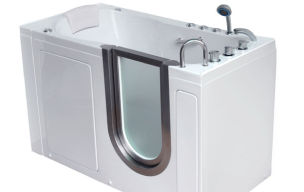Aging gracefully is a goal that we all strive for. Certain physical limitations might make daily activities more challenging as we age. Seniors frequently struggle with mobility challenges, hearing loss, and other age-related issues. Fortunately, advances in technology and smart design have resulted in a variety of devices that make senior living more comfortable and enjoyable. In this post, we will look at some of the developments that cater to the specific needs of our beloved seniors, such as walk-in tubs and hearing aids.
The Walk-In Tub Revolution
Bathing can be difficult for elders due to diminished mobility and balance concerns. Traditional bathtubs, with their high edges that require getting in and out, might be a safety issue. This is where walk-in tubs come in handy. Walk-in tubs have transformed bathing for seniors, providing a safe and convenient way to maintain cleanliness while still enjoying a peaceful dip.
Walk-in baths have a readily accessible door, which eliminates the need to step over high walls. Seniors can just stroll in, open the door, and sit comfortably in the built-in seat. The watertight door prevents leaks, and most models include non-slip flooring, handrails, and easy-to-reach controls for enhanced safety.
Aside from safety, walk-in tubs provide therapeutic benefits. Many of these bathtubs include hydrotherapy capabilities that can help with arthritis pain, muscle stress, and circulation problems. Seniors can enjoy a spa-like experience in the comfort of their own homes thanks to the warm water and relaxing jets. As a result, walk-in baths not only promote cleanliness but also general well-being.
Hearing Aids: A Bridge to Better Communication
Hearing loss is a prevalent problem among the elderly. It might result in feelings of loneliness and dissatisfaction, as well as difficulty engaging in conversations and social activities. Hearing aids have become crucial instruments for bridging the gap between the world of sound and people who struggle to hear.
Hearing aids now are a long cry from the bulky, unpleasant devices of yesteryear. They are now inconspicuous, highly effective, and frequently customized to a person's exact needs. They use digital technology to magnify sounds and filter out background noise, allowing seniors to hear and interpret conversations, music, and other noises in their environment more easily.
Some hearing aids can even be Bluetooth-connected to smartphones or other devices, allowing seniors to change settings, stream phone calls and music, and even receive notifications right into their ears. This link not only improves hearing but also ensures that elders can stay connected in a quickly changing digital world.
Hearing aid design innovations also address issues about comfort and attractiveness. Many models are now available in a variety of shapes and sizes, including discreet in-ear or behind-the-ear alternatives, allowing seniors to select a style that best meets their needs. Some are even made to match a senior's hair color or skin tone, further blending into their appearance.
The Convenience of Mobility Scooters
Getting around freely might be difficult for seniors who have mobility issues. Mobility scooters have grown in popularity as an effective option, offering seniors with limited mobility with a fresh sense of freedom and ease of movement.
These scooters are built for comfort and convenience of usage. They have comfy seats, adjustable armrests, and simple controls. Mobility scooters are available in a variety of styles, ranging from compact and folding interior models to sturdy outdoor models capable of tackling a variety of terrains. This adaptability allows seniors to maintain an active lifestyle, whether it's running errands, visiting friends and family, or enjoying the great outdoors.
Safety and Stability: Grab Bars and Ramps
Simple home adjustments can make a huge difference in the lives of elders. Installing grab bars and ramps in important sections of the home can improve safety and accessibility dramatically.
Grab bars, for example, can be positioned beside toilets and bathtubs in bathrooms to help when sitting or standing. They can also be placed in corridors and near beds to assist seniors in maintaining their balance as they move around the house. These bars are available in a variety of forms and materials, allowing them to blend in with the décor of a senior's house.
In contrast, ramps allow a smooth and stable transition from one level to another. They are particularly useful for seniors who rely on mobility aids such as wheelchairs or scooters. Ramps can be constructed at home entrances and exits to make it easier for elders to arrive and go. They can also be utilized to navigate internal steps and changes in floor elevation, making the entire living space more accessible.
Senior-Friendly Technology: Smart Home Solutions
The digital age has given us smart home technology, which is very advantageous to elders. These devices can increase home safety, security, and comfort.
Smart lighting solutions, for example, allow seniors to modify the brightness and hue of their lights, making it easier to see and providing a more comfortable environment. Smart locks give an extra layer of security, while smart thermostats keep the temperature exactly right. Voice-activated assistants, such as Amazon's Alexa or Google Assistant, can aid with activities like making reminders, answering inquiries, and managing other smart devices.
Medical alert systems are another important component of the smart home ecosystem. These devices, which are typically worn as pendants or bracelets, allow elders to summon assistance in the event of an emergency, providing both seniors and their family with peace of mind.
As our aging population's demands change, so does the range of options available to make senior living more comfortable and pleasurable. We can ensure that our elders enjoy their golden years to the fullest by adopting these advancements.



